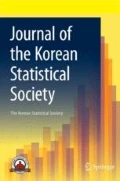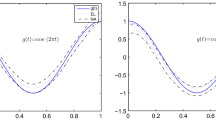Abstract
Semiparametric models are often used to analyze panel data for a good trade-off between parsimony and flexibility. In this paper, we investigate a fixed effect model with a possible varying coefficient component. On the basis of empirical likelihood method, the coefficient functions are estimated as well as their confidence intervals. The estimation procedures are easily implemented. An important problem of the statistical inference with the varying coefficient model is to check the constant coefficient about the regression functions. We further develop checking procedures by constructing empirical likelihood ratio statistics and establishing the Wilks theorems. Finally, some numerical simulations and a real data analysis is presented to assess the finite sample performance.





Similar content being viewed by others
References
Ahkim, M., & Verhasselt, A. (2018). Testing for constancy in varying coefficient models. Communications in Statistics-Theory and Methods, 47(4), 890–911.
Chen, R., Li, G. R., & Feng, S. (2020). Testing for covariance matrices in time-varying coefficient panel data models with fixed effects. Journal of the Korean Statistical Society, 49, 82–116.
Chen, S. X., Härdle, W., & Li, M. (2003). An empirical likelihood goodness-of-fit test for time series. Journal of the Royal Statistical Society: Series B (Statistical Methodology), 65(3), 663–678.
Chen, S. X., & Cui, H. J. (2006). On Bartlett correction of empirical likelihood in the presence of nuisance parameters. Biometrika, 93, 215–220.
DiCicco, T., Hall, P., & Romano, J. (1991). Empirical likelihood is Barterlett correctable. Annals of Statistics, 19, 1053–1061.
Fan, J., & Zhang, J. T. (2000). Two-step estimation of functional linear models with applications to longitudinal data. Journal of the Royal Statistical Society: Series B (Statistical Methodology), 62(2), 303–322.
Fan, J., Zhang, C., & Zhang, J. (2001). Generalized likelihood ratio statistics and Wilks phenomenon. The Annals of Statistics, 29(1), 153–193.
Fan, J., & Huang, T. (2005). Profile likelihood inferences on semiparametric varying-coefficient partially linear models. Bernoulli, 11(6), 1031–1057.
Feng, S., Li, G., Peng, H., & Tong, T. (2021). Panel data varying coefficient models with interactive fixed effects. Statistica Sinica, 31, 935–957.
Green, C. D. A. (2015). Three Essays on Nonparametric and Semiparametric Methods and Their Applications (Doctoral dissertation).
He, B. Q., Hong, X. J., & Fan, G. L. (2017). Block empirical likelihood for partially linear panel data models with fixed effects. Statistics & Probability Letters, 123, 128–138.
Hoover, D. R., Rice, J. A., Wu, C. O., & Yang, L. P. (1998). Nonparametric smoothing estimates of time-varying coefficient models with longitudinal data. Biometrika, 85(4), 809–822.
Huang, J. Z., Wu, C. O., & Zhou, L. (2002). Varying-coefficient models and basis function approximations for the analysis of repeated measurements. Biometrika, 89(1), 111–128.
Li, D., Chen, J., & Gao, J. (2011). Non-parametric time varying coefficient panel data models with fixed effects. The Econometrics Journal, 14(3), 387–408.
Li, G., Peng, H., & Tong, T. (2013). Simultaneous confidence band for nonparametric fixed effects panel data models. Economics Letters, 119(3), 229–232.
Li, G. R., Lian, H., Lai, P., & Peng, H. (2015). Variable selection for fixed effects varying coefficient models. Acta Mathematica Sinica, English Series, 31(1), 91–110.
Li, N., Xu, X., & Liu, X. (2011). Testing the constancy in varying-coefficient regression models. Metrika, 74(3), 409–438.
Owen, A. (1990). Empirical likelihood ratio confidence regions. The Annals of Statistics, 18(1), 90–120.
Owen, A. B. (1998). Empirical likelihood. Chapman and Hall/CRC.
Su, L., & Ullah, A. (2006). Profile likelihood estimation of partially linear panel data models with fixed effects. Economics Letters, 92(1), 75–81.
Su, L., & Lu, X. (2013). Nonparametric dynamic panel data models: Kernel estimation and specification testing. Journal of Econometrics, 176(2), 112–133.
Wang, H. J., Zhu, Z., & Zhou, J. (2009). Quantile regression in partially linear varying coefficient models. The Annals of Statistics, 37(6B), 3841–3866.
Wang, H., Zhong, P.-S., Cui, Y. & Li, Y. (2018). Unified empirical likelihood ratio tests for functional concurrent linear models and the phase transition from sparse to dense functional data. Journal of the Royal Statistical Society Statistical Methodology Series B, 80, 343–364.
Wu, C. O., Chiang, C. T., & Hoover, D. R. (1998). Asymptotic confidence regions for kernel smoothing of a varying-coefficient model with longitudinal data. Journal of the American Statistical Association, 93(444), 1388–1402.
Xue, L., & Zhu, L. (2007). Empirical likelihood for a varying coefficient model with longitudinal data. Journal of the American Statistical Association, 102(478), 642–654.
Yang, Y., Li, G., & Peng, H. (2014). Empirical likelihood of varying coefficient errors-in-variables models with longitudinal data. Journal of Multivariate Analysis, 127, 1–18.
Zhao, P., & Xue, L. (2010). Empirical likelihood inferences for semiparametric varying-coefficient partially linear models with longitudinal data. Communications in Statistics-Theory and Methods, 39(11), 1898–1914.
Zhao, P., & Yang, Y. (2015). Semiparametric empirical likelihood tests in varying coefficient partially linear models with repeated measurements. Statistical Methodology, 23, 73–87.
Zhu, L., Qin, Y., & Xu, W. (2007). The empirical likelihood goodness-of-fit test for regression model. Science in China, Series A, 50, 829–840.
Funding
This work is supported by the National Social Science Foundation of China (No. 17BTJ026).
Author information
Authors and Affiliations
Corresponding author
Additional information
Publisher's Note
Springer Nature remains neutral with regard to jurisdictional claims in published maps and institutional affiliations.
Appendix A. Proof of the lemmas and theorems.
Appendix A. Proof of the lemmas and theorems.
It is to start with some preliminary results about the naive empirical likelihood ratio. The proof of the theorems can be obtained by extending some of them, which is shown as the following lemmas and proof for them.
Lemma 1
Under some conditions (C1)-(C6), then when \(n\rightarrow \infty\), we have
and
where \(\Sigma ^*(t_0)=\nu ^2_0(t_0)\Gamma (t_0).\)
Proof
Denote \({\tilde{\zeta }}(t_0) = \frac{1}{\sqrt{Nh}}\sum _{i=1}^n{\tilde{\eta }}_i(\theta (t_0))\) and its l-th component being \({\tilde{\zeta }}_l(t_0)= \frac{1}{\sqrt{Nh}}\sum _{i=1}^n{\tilde{\eta }}_{i,l}(\theta (t_0)).\) Hence, together with the Eqs. (2.5) and (2.6), it is shown that
and
By the conditions (C1) and Taylor expansion, an algebra calculation of the right side of the above formula leads to
For the second item in Lemma 1, the (l, k)-th component of the covariance matrix is
So after plugging the notation of \({\tilde{\zeta }}(t_0)\), the first term on the right side is
As to the first term in (A.1),
And as \(n\rightarrow \infty\), a straightforward calculation leads to that
Therefore,
With a similar derivation of the second term in (A.2), we can obtain
and a further expectation follows that
Combining (A.3) and (A.4) with (A.2), when \(n\rightarrow \infty\), we have
where \(h^*=hN^{-1}(\sum _{i=1}^nm_i^2-N)\). With \(h=N^{-1/5}h_0\) and \(\lim _{n\rightarrow \infty }N^{-6/5}\sum _{i=1}^n m_i^2=\lambda\), we have
Following a similar context of (A.13) in Wu et al. (1998), it follows that
Sum up (A.5), (A.6), the second result in Lemma 1 is concluded. \(\square\)
Lemma 2
Under conditions (\(\text {C1}\))–(C6) hold, then
Proof
The proof is similar to that one of Lemma A.1 in Xue and Zhu (2007). \(\square\)
Lemma 3
Suppose that conditions (C1)–(C6) hold, and for a given \(t_0\),
where \(B(t_0)=f(t_0)^{-1}\Gamma ^{-1}(t_0)b(t_0)\), \(\Sigma (t_0)=f(t_0)^{-2}\nu ^2(t_0)\Gamma ^{-1}(t_0)\), \(\Gamma (t_0)\) is defined in condition (C6), \(b(t_0)=(b_0(t_0), \ldots ,b_p(t_0))\), \(b_l(t_0)\) and \(\nu ^2(t_0)\) are defined by
and
where \(h_0\) and \(\lambda\) are defined in conditions (C1) and (C2).
Proof
With a similar proof of (A.1) in Wu et al. (1998) and a straightforward calculation, we can derive that
By Lemma 1, we can derive that
Invoking (A.8) and (A.9), we can show the result in Lemma 3 . \(\square\)
Lemma 4
Suppose that conditions (C2)–(C6) hold and \(Nh\rightarrow \infty\), \(h=o(N^{-1/5})\), if \(\theta (t_0)\) is the true parameter, then
where \({\mathop {\longrightarrow }\limits ^{{\mathcal {L}}}}\) stands for convergence in distribution and \(\chi _p^2\) means the chi-squared distribution with freedom p.
Proof
It is easy to see that the proof of Lemma 4 requires the following three asymptotic results as
Firstly, by Lemma 1, when \(Nh\rightarrow \infty\), \(Nh^5\rightarrow 0\), we can obtain (A.11).
Secondly, according to the proof of (A.6) in Lemma 1, we have (A.12).
Following the Taylor expansion of \(\frac{1}{Nh}\sum _{i=1}^n\frac{{\tilde{\eta }}_i(\theta (t_0))}{1+\lambda ^T {\tilde{\eta }}_i(\theta (t_0))}=0\), then
And by the proof of (2.16) in Owen (1998), the last term, on the right side of the foregoing equation, has a norm bounded by
Then,
Again, applying the Taylor expansion to (2.8), we obtain that
Following the proof of (A.12) in Wu et al. (1998), we obtain that \({\tilde{D}}(\theta (t_0))\xrightarrow {{\mathcal {P}}}\Sigma ^*(t_0)\). And taking together (A.8), (A.9) and (A.10), it can be proven that
\(\square\)
To prove Theorem 4, we show the following Lemma 5, which can be verified similarly to the proof of Lemma 7.2 in Zhu et al. (2007).
Lemma 5
Suppose that conditions (C1)-(C6) hold, then under \(H_{1n}\),
-
(a)
if \(n^\gamma C_n\rightarrow\)a (a is a constant), \(0\le \gamma <\frac{1}{2}\), \(\sqrt{n}{\hat{\psi }}_1\rightarrow \infty\), as \(n \rightarrow \infty\);
-
(b)
if \(n^{\frac{1}{2}} C_n\rightarrow 1\), \(\sqrt{n}{\tilde{\psi }}_1\xrightarrow {{\mathcal {L}}}N(\mu ,\sigma ^2)\), where \(\mu = E\left\{ W(X, \theta )X^{(2)T}\theta ^{(2)}(t)\right\}\).
\(\square\)
Proof of Theorem 1
Firstly, by a proof similar to that of Lemma 1, we can derive that
Specially, according to the estimator \({\hat{\theta }}_{\text {RAEL}}(t_0)\), we have
Furthermore, together with the proof context of Lemma 3, it is shown that
Hence, this thereupon completes the proof of Theorem 1. \(\square\)
Proof of Theorem 2
To prove that under some regularity conditions,
Now, we have
By the Taylor expansion and \(\theta _l'(t_0)-{\hat{\theta _l}}'(t_0)\xrightarrow {P}0\), we derive \(I_2+I_3\xrightarrow {P}0.\) So, together with the fact that
and
Theorem 2 can be derived along with the argument in the proof in Lemma 4. \(\square\)
Proof of Theorem 3
From the fixed effect-corrected technique in Sect. 2, we have \(E\big [Y_{ij}^*-X_{ij}^{^*T}\theta |X_{ij}^*\big ] = 0\) and further assume a auxiliary vector as
Denote an estimator for \(\theta\) be \({\tilde{\theta }}_n\), \({\tilde{w}}_{ij} \triangleq w(X_{ij}^*,{\tilde{\theta }}_n)\) and \(w_{ij} \triangleq w(X_{ij}^*,\theta )\), then
Consider
By using a similar proof of the Lemma 7.1 in Zhu et al. (2007), we have
where \(\sigma ^2 =\lim _{n\rightarrow \infty }n^{-1}\sum _{i=1}^{n}\sum _{j=1}^{m_i} E \big [ {\tilde{w}}_{ij}\varepsilon _{ij}-{\tilde{w}}_{ij}X_{ij}^{^*T}L(X_{ij}^*,\theta _0)\big ]^2\) and \(L(X_{ij}^*,\theta _0)\) is the asymptotical expression of \((\theta _n-{\tilde{\theta }}_0)\) proposed in Zhu et al. (2007). Then, by the law of Large Numbers, we can obtain that
where \(\sigma _1^2 = \lim _{N\rightarrow \infty }N^{-1}\sum _{i=1}^{n}\sum _{j=1}^{m_i} E ( {\tilde{w}}_{ij}\varepsilon _{ij})^2\).
Together with the standard procedure in the empirical likelihood literature, one can find that
Then combined with with (A.25), we derive that
Therefore, by (A.24) and (A.27), we have
where \(\chi ^2_{1}\) is a random variable of chi-squared distribution with degree freedom of 1 . \(\square\)
Proof of Theorem 4
According to the definition of \({\hat{w}}_{ij}\) in Sect. 3, we have
Then,
By the feature of \({\hat{w}}_{ij}\) being orthogonal to \(X_{ij}^*\), the second term in (A.29) tends to 0 as \(n\rightarrow \infty\). And by the CLT, we can easily conclude that
Furthermore, invoking the proof in Theorem 3, one can show that
Hence, together with the decomposition
we can prove the Theorem 4. \(\square\)
Proof of Theorem 5
By Lemma 5, similar to the proof of Theorem 4, we can obtain Theorem 5. \(\square\)
Rights and permissions
About this article
Cite this article
Li, W., Xue, L. & Zhao, P. An empirical likelihood check with varying coefficient fixed effect model with panel data. J. Korean Stat. Soc. 51, 198–222 (2022). https://doi.org/10.1007/s42952-021-00136-2
Received:
Accepted:
Published:
Issue Date:
DOI: https://doi.org/10.1007/s42952-021-00136-2



